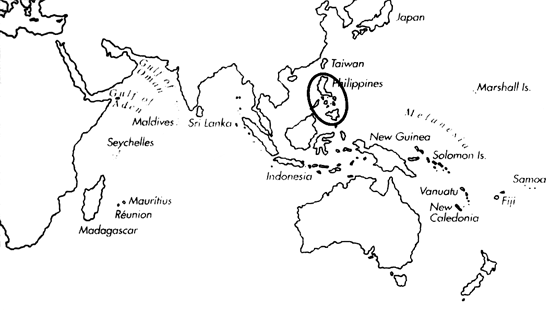Range: Philippines.
Description: Small to moderately small, light. Last whorl conical, outline straight. Shoulder angulate to subangulate. Spire of moderate height to high, outline nearly straight. Larval shell of 2.5 whorls, maximum diameter 0.8-0.9 mm. First 4-6 postnuclear whorls weakly tuberculate; in first whorl, tubercles at both margins and on intervening spiral rib. Teleoconch sutural ramps flat to slightly concave, with 2 increasing to 3-4 spiral grooves in early and spiral striae in late whorls. Last whorl almost smooth.
| Shell Morphometry | ||
|---|---|---|
| L | 23-33 mm | |
| RW | 0.04-0.06 g/mm | |
| RD | 0.52-0.60 | |
| PMD | 0.87-0.95 | |
| RSH | 0.22-0.31 | |
Ground colour cream. Last whorl with broad brown spiral zones leaving 3 narrower reticulated spiral bands, at centre, shoulder and base and 1-3 similarly patterned axial streaks; colour zones overlaid with spiral lines of alternating brown and tan dots and dashes. Larval whorls white. Postnuclear sutural ramps with brown dots and spots as well as reticulated radial lines and blotches. Aperture white.
Periostracum brown, thin, translucent.
Habitat and Habits: In 100-200 m.
Discussion: C. dondani superficially resembles juvenile shells of C. gloriamaris and C. bengalensis (see Kosuge, 1981). However, the latter species are clearly distinguished by their narrower last whorls (C. gloriamaris: RD 0.45- 0.50; C. bengalensis: RD 0.36-0.46) with a typical C. textile pattern.

C. dondani range map
This section contains verbatim reproductions of the accounts of 316 species of Conus from the Indo-Pacific region, from Manual of the Living Conidae, by Röckel, Korn and Kohn (1995). They are reproduced with the kind permission of the present publisher, Conchbooks.
All plates and figures referred to in the text are also in Röckel, Korn & Kohn, 1995. Manual of the Living Conidae Vol. 1: Indo-Pacific Region.
The range maps have been modified so that each species account has it own map, rather than one map that showed the ranges of several species in the original work. This was necessary because each species account is on a separate page on the website and not confined to the order of accounts in the book.